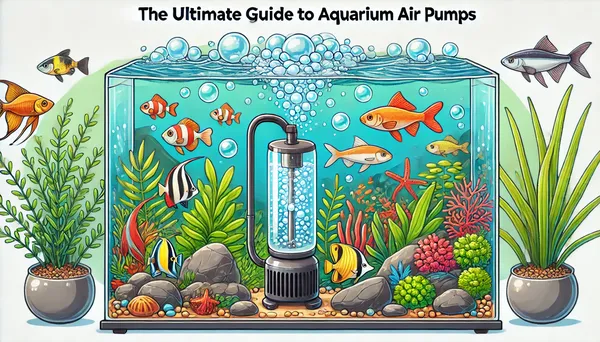An aquarium air pump does more than just makes air bubbles, it also plays a role in maintaining the tank’s overall water quality, meaning happy and healthy fish. In this guide, we’ll dive into an overview of everything you need to know about aquarium air pumps, from their functions and types to setup, maintenance, and how they work with accessories like airstones and sponge filters. Afterwards, if interested in reading our review of the 7 best air pumps, then follow this link.

Why Use an Aquarium Air Pump?
Aquarium air pumps, sometimes called aquarium aerators, serve several essential purposes in a fish tank.
Water Oxygenation
One of the primary functions of an aquarium air pump is to boost the oxygen levels in the water. Fish and beneficial bacteria rely on oxygen to survive, and the bubbles created by the pump increase the water surface agitation, enhancing the gas exchange process with the surrounding environment. This is especially important for aquariums that are densely stocked or contain species that require high oxygen levels. For better results, many fish keepers attach an air stone to their air pump, which disperses the air into smaller bubbles, which provides additional surface area and agitation further the oxygenation.
Water Circulation
An air pump will also generate water movement. The rising bubbles encourage water flow, which helps prevent dead zones where water might stagnate. (In short, the water is pulled into the space that the gas bubble left behind as it travels to the surface, thus creating a gentle flow of water in the bubble direction.) This circulation aids with the even distribution of nutrients and maintenance of a consistent water temperature in the aquarium. For tanks with limited filtration, an air pump connected to a sponge filter air pump setup can significantly improve both water movement and filtration, and also makes a low cost, pre-seeded back up filter for times of emergency or to speed up the cycling process of a new tank.

Aesthetic Appeal
Beyond practical benefits, adding one or two air pumps, particularly with an air stone attached, can enhance the visual appeal of an aquarium. The gentle cascade of bubbles can make the aquarium more engaging to watch and give it a lively atmosphere. Using a fish tank bubbler decoration, like a treasure chest or other ornamental bubblers, can add an extra layer of aesthetic charm, especially in themed tanks.

Types of Aquarium Air Pumps
Not all air pumps are the same. Here’s a breakdown of the different types to help you pick the best fish tank air pump for your setup:
Internal vs. External
– Internal Air Pumps: These are placed inside the aquarium and are generally smaller and quieter. They work well for small fish tanks or setups where noise is a concern. Some internal filters have these included within them to help save space within the tank.
– External Air Pumps: Positioned outside the aquarium, external pumps are often more powerful, making them ideal for larger tanks. However, they can be noisier, so placing them on a soft surface can help reduce vibration, and keep an eye out for models that have rubber feet to further reduce the sound they can cause.
Battery-Powered and USB-Rechargable Portable Air Pumps
A battery air pump for aquariums is perfect for emergencies, such as power outages. Having a backup air pump on hand can save fish from low-oxygen conditions during unexpected power loss. They can also come in handy if needing to transport fish for a longer distance, eg a house move. Some models are even USB rechargeable, making them convenient for both permanent setups and temporary or portable tanks.
For smaller tanks, quarantine setups, or temporary displays, these rechargable and battery operated air pumps offer a compact and flexible solution. They are often also chosen for nano tanks or transporting fish short distances, though they may lack the capacity needed for larger, heavily stocked aquariums. Unlike silent air pumps, however, USB and battery-powered models can sometimes produce a more slight hum, so positioning is important if noise is a concern. Though that’s often the least of your worries in an emergency!
Silent Models
As the name suggests, silent air pumps are designed to operate with minimal noise, making them ideal for aquariums located in bedrooms or living rooms where quiet is important. These models use advanced engineering to minimise vibration and may come with sound-dampening features to further reduce noise.

Choosing the Right Fish Tank Air Pump
Choosing the right air pump can seem complicated, but keeping a few key factors in mind can help make it easier.
Tank Size
The size of your aquarium is one of the most important factors in selecting an air pump for aeration. Larger tanks need more powerful pumps to ensure adequate oxygenation and water circulation. Many manufacturers list the recommended tank size for their air pumps, so check the specifications to find a model that matches your aquarium’s needs.
Noise Level
As discussed above, noise can be a consideration, depending on the aquarium location, especially if the pump is against a hard surface. If your aquarium is in a quiet room, look for a silent air pump or try placing it on a soft surface to dampen the noise.
Energy Efficiency
Energy-efficient air pumps can help reduce electricity costs, especially if you run your tank continuously. Look for models that offer good performance without using excessive power. Some modern air pumps balance power and efficiency well, providing reliable oxygenation at a lower operating cost.
Aquarium Air Pump Brands
Brands like Tetra, Fluval, and Hygger are known for producing quality air pumps. Each brand offers a range of products with varying features, from basic models to advanced, adjustable air pumps. Reading reviews and comparing products can help you choose a reputable fish air pump that fits your needs and budget, else, to save the hassle, stay tuned for our upcoming post reviewing the best aquarium air pumps.
Want to find the right aquarium air pump for you? Follow this link for our review of the 7 best air pumps for fisk tanks.

Setting Up Your Aquarium Air Pump
Proper setup ensures your aquarium aerator functions efficiently and safely. Here’s how to get started:
1. Placement: Position the air pump above the water level to prevent water from flowing back into the pump if it turns off or if there’s a power outage. Alternatively, make sure you do step 3.
2. Connect Tubing: Attach airline tubing from the pump to your chosen device, such as an airstone or a sponge filter. Ensure the tubing is secure and free of kinks to allow unrestricted airflow.
3. Install a Check Valve: A check valve, or anti-backflow valve, prevents water from siphoning back into the pump. This is especially useful if the pump is positioned below the tank’s water level. For this, insert the anti-backflow valve within the air tubing at the same height as the water level. Be sure to read the instructions on the back of the packet to ensure it is installed facing the correct direction.
4. Power Up: Plug in the pump and adjust the airflow if your model allows it. Many air pumps come with adjustable settings, letting you control the strength of the bubbles. Alternatively, you can purchase small flow adjustment valves that you can insert anywhere along the airline tubing to give you this control feature.
Maintenance Tips for Fish Tank Air Pumps
Regular maintenance will help to prolong the life of your air pump and ensuring it continues to run efficiently.
Regular Cleaning
Over time, debris and algae can clog airline tubing or air stones, reducing airflow. Clean or replace the airstone periodically and check the tubing for blockages. A clean fish tank bubbler works more effectively and produces a steadier stream of bubbles. Also keep an eye out for cracks along the airline tubing. As it starts to age it can turn brittle, which is when this will most likely start to occur. Fortunely, materials used for the tubing these days have pretty good life spans, as long as they are kept out of direct sunlight.
Check for Wear and Tear
Inspect the air pump regularly for signs of wear, especially the rubber diaphragm inside the pump. This part can degrade over time and may need replacement. Replacing worn parts is usually much cheaper than buying a new pump.
Monitor Noise Levels
If your pump becomes louder over time, it might indicate a problem. Often, simply placing the pump on a soft surface or adjusting the tubing can resolve noise issues. If not, contact the manufacturer or consider replacing the pump.
Do You Need an Aquarium Air Pump?
Whether or not you need an air pump depends on several factors, including your tank setup, stock levels, and filtration system.
– Heavily Stocked Tanks: Tanks with many fish or active species benefit significantly from the additional oxygenation provided by a fish tank air pump.
– Low Water Movement: If your tank lacks water flow, an air pump can help to maintain circulation and prevent dead zones.
– Filtered Tanks: In tanks with strong filters that create surface agitation, a separate air pump might not be necessary. However, a small fish tank bubbler or sponge filter air pump can still be beneficial for emergency oxygenation or adding gentle flow to specific areas.
An aquarium air pump is a small but powerful tool that can make a big difference in the health and aesthetic appeal of your tank. Your tank set up may not need one, but you might consider adding one for the visual appeal or as a backup for those unexpected emergencies. They are typically low cost and low maintenance, especially relative to the value-add they bring to a tank.
If interested in finding the right air pump for your aqurium, read this post next.




